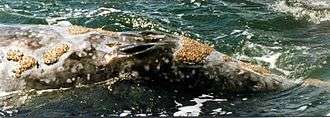Epibiont

An epibiont (from the Ancient Greek meaning living on top of) is an organism that lives on the surface of another living organism.[1] An epibiont is by definition harmless to its host; in this sense, the relationship between the two organisms can be considered neutralistic or commensalistic (as opposed to, for example, parasitic, in which case one organism benefits at the expense of the other, or mutualistic, in which both organisms obtain some explicit benefit from their coexistence). Examples of common epibionts are barnacles, remoras and algae, many of which live on the surfaces of larger marine organisms such as whales, sharks, sea turtles and mangrove trees. The host of the epibiont is typically referred to as the basibiont (living underneath).[2]
Types
- Epiphytes are plants that grow on the surface of other plants.
- Epizoic organisms are those that live non-parasitically on the surface of animals.[3] Examples of epizoic species include mosses, algae, and fungi growing on Gymnopholus weevils, and bryozoans (moss animals) growing on other animals.
See also
References
- ↑ H. L. Lescinsky (2001). "Epibionts". In Derek E. G. Briggs & Peter R. Crowther. Palaeobiology II. Wiley-Blackwell. pp. 460–463. doi:10.1002/9780470999295.ch112. ISBN 978-0-632-05149-6.
- ↑ Gregorio Fernandez-Leborans; Yukio Hanamura; Ryon Siow; Phaik-Ean Chee (2009). "Intersite epibiosis characterization on dominant mangrove crustacean species from Malaysia". Contributions to Zoology. 78 (1): 9–23.
- ↑ http://www.oxforddictionaries.com/us/definition/american_english/epizoic